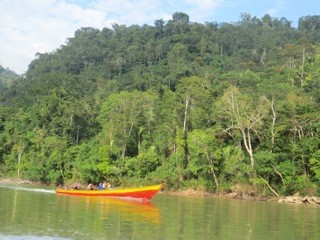
Agathe Faure
MRes Social Anthropology
University College London
I conducted ethnographic fieldwork from May to July 2015 in villages of cacao farmers along the river of Alto Huayabamba, Peruvian Amazonia. Employed by an international company providing environmental services, I was to observe environmental programmes through their local implementation in the area. I quickly realised that the Alto Huayabamba had been the arena of complex dramaturgies.
First covered by cornfields, providing just enough to cover farmers’ basic necessities, the region became a red zone of coca production in the 1960s. According to the U.S. State Department (1991), 200,000 acres of coca were cultivated in the region in 1990, being 40% of the world coca crop. Under growing pressure from the United States, the Peruvian government began a series of U.S. funded coca eradication in the region (Kawell 1995: 405). Alto Huayabamba was left completely depleted, socio-economically and environmentally. National and transnational environmental organisations, orchestrated by USAID, decided to re-construct a profitable space to grow another plant, cacao[1], setting up a new production scenery, in response to global trends of neoliberalised nature. Environment was then built as what Dasgupta (2007) calls “natural capital”, i.e. a resource base for wealth to grow through the dynamics of extracting from, polluting and conserving.
During my fieldwork, I could observe the evolution of environmental conservation towards neoliberal concerns. Environmental programmes there approached conservation as being potentially achieved through the sustainable development of economic markets that are based on in situ biological diversity. These markets were seen to enable the flow of income to reach “poor people” living in biologically diverse places (see West 2006: xii). In turn, these people were to conserve the biological diversity on which the markets they now rely on are based.
Consequently, environmental programmes there created what West (ibid.) calls “conservation-as-development projects”, which assume that environmental conservation can engender economic development for rural peoples, and that what the latter need and want in terms of development is to be met by biodiversity on their lands. The script was clear: in exchange for modernisation and good cacao production, farmers had to take on the role of conservationists in order to justify the market of environmental services now recruiting them.
I first feared that farmers were taking their new parts too seriously, as, during my first weeks there, they seemed to be shaped beyond their discourses, i.e. in their own subjectivities. The analysis of everyday practice in lived experiences however revealed that farmers were actually re-enacting themselves in a place they were themselves actively producing. Fieldwork allowed me to nuance my first judgements. I now agree with Mohan (2001: 164): if inequalities of power in spaces exist, they create hybrid places that those viewed as powerless can actively contribute to produce. Intersections of spaces allow new possibilities for challenging hegemonic power relations (Gaventa 2004: 39). In Alto Huayabamba, the opening of previously closed spaces (corn and coca) has indeed actually contributed to new mobilizations and critical consciousness. Environmental programmes did provide possibilities for transformational change. Environment was then used to construct a socio-political and ecological place, seen as a place of “tranquillity”[2]. Slowly growing, cacao trees allowed farmers to benefit from a socio-economic rebirth and re-create a space of support and security. Farmers were often comparing the strength of trees, the difficulties in growing them and taking care of them through time to how strong they were feeling socially in a new environment of union and cohesion. Cacao trees were depicted as the emblem of “stability”[3]. As opposed to coca plants, growing quickly and easily everywhere, impoverishing soil, giving what people described as “quick money”, cacao trees were environmentally and socially constructive.
Far from merely parroting discourses or acting as ventriloquists, farmers were actually playing their own role in order to benefit socio-economically from a new opened environment. They were using neoliberalised power relations to construct their own place of tranquillity and locality of agricultural communities.
Bibilography
Dasgupta, P. (2007) ‘Nature And The Economy’, Journal of Applied Ecology,
44 (3), pp. 475-487.
Gaventa, J. (2004) ‘Towards participatory governance: assessing the
transformative possibilities’. In S. Hickey and G. Mohan (eds) Participation: From tyranny to transformation, London: Zed Books, pp 25-41.
Kawell, J.A. (1995) ‘The Cocaine Economy’ In O. Starn, C. Degregori and R. Kirk (eds) The Peru Reader. History, Culture and Politics. Durham: Duke University Press.
Mohan, G. (2001) ‘Beyond Participation: Strategies for Deeper
Empowerment’. In B. Cooke and U. Kothari (eds) Participation: The New
Tyranny? London: Zed Books, pp. 153-67.
U.S. State Department (1991) International Narcotics Control Strategy Report.
West, P. (2006) Conservation is our government now: the politics of ecology
in Papua New Guinea. Durham: Duke University Press.
Footnotes
[1] a small tropical evergreen tree, which bears cacao seeds, from which cocoa, cocoa butter and chocolate are made.
[2] “tranquilidad”
[3] “estabilidad”

